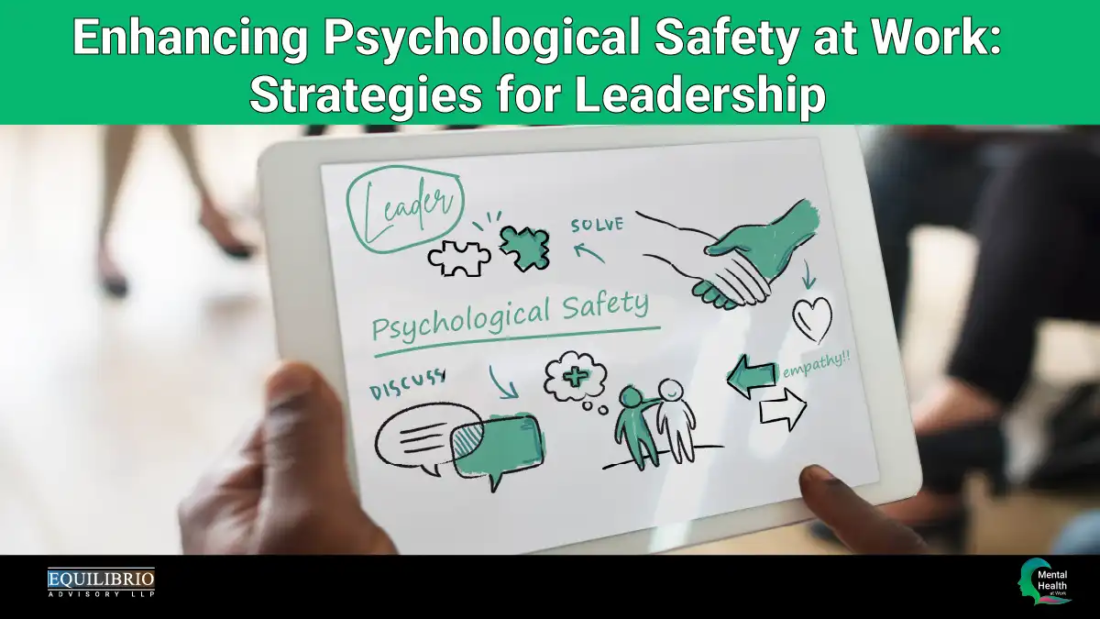When we understand psychological safety, we must remember that to nurture an environment that promotes psychological safety, we need to adopt a top down approach ŌĆō one that has invested leadership, engage with teams with the intention to build safe teams and workplaces.┬Ā
In our previous article we explored and established the ŌĆ£whyŌĆÖsŌĆØ – benefits of psychological safety like realizing the promises of diversity, enhancing problem solving and innovation, building team resilience and more.┬Ā┬Ā
What we need to remember is that the journey to psychological safety at work is a long one and may not be as neat and linear as we would like it to be. We also need to bring in compassion for ourselves, as the journey to reframing concepts we know, adopting a new style of leadership than what we have seen and understood in the past while not impossible, is not without its own challenges.
Given the context, as leaders, how do we hold on to our intentions regarding psychological safety at work? How do leaders effectively nurture and manage teams leveraging psychological safety?
In this article, we will be delving into the role of Leadership in establishing psychological safety at work, exploring the intersections and offering insights and guidance for leaders aiming to create a supportive and productive workplace environment for teams to flourish.
Exploring the role of Leadership when it comes to psychological safety at work:┬Ā
Experience and research tell us that it is integral that leadership, at all levels, must display certain behaviours to ensure that teams flourish at work. Merely sending out mailers promoting psychological safety or awareness sessions for employees encouraging them to be candid and take risks wonŌĆÖt work, if employees are stressed, disconnected from their leadership and management, isolated and lonely (especially in WFH/hybrid models of work), burnt out and confused about their roles, contributions and space within the team.
According to research by Workhuman (circa 2021), psychological safety is highest for employees who check in with their manager at least once per week, and for those recognized / thanked for their work, and lowest for those who were never thanked / appreciated for their work – in the research, only 29% of respondents said they checked in with their management weekly, and only 51% of respondents said theyŌĆÖve been thanked at work in the last month.
Furthermore, recent data by BCG (circa 2024) indicates that when empathetic leaders build a culture of psychological safety, the data shows, retention risk is reduced.ŌĆ»
This indicates that the role of the leader must be more intentional, consistent and active for psychological safety to thrive at work, which is involving activities over and above sending out mailers promoting psychological safety, organizing awareness sessions for employees encouraging them to be candid and offering mental health support when employees are stressed, isolated and lonely (especially in WFH/hybrid models of work), burnt out and confused about their roles, contributions and space within the team.
Building leadership skills and practice to invite psychological safety into team environments:┬Ā
When checking in with your internal practices, having a tool to reference may be helpful, so weŌĆÖve listed a set of practices to keep in mind when looking to develop effective leadership practices over time that supports psychological safety at work. Each of these strategies may support leaders by providing a structured approach to interactions with teams and peers at the workplace.
Take a moment for yourself as you go through below tool. You can rate yourself on 10, with 0 being no action, and 10 being most action, and periodically look at where you may be on this scale.
| Tool for Leaders at Work |
| Have I established clear norms and expectations with my team?┬Ā |
| Do I engage in fair and just treatment and practice with those at work?┬Ā |
| Do I encourage open communication, consistently and regularly with all of my team?┬Ā |
| Do I foster candid conversation by asking questions that are open-ended?┬Ā |
| Do I have multiple open channels that support team members to share their thoughts – even anonymously?┬Ā |
| Do I lead by example, modelling vulnerability, accountability and openness?┬Ā |
| Have I been responding effectively and mindfully (applying active listening, humility, checking my own emotional state, accountability, openness, overt appreciation for sharing) when employees speak up around me?┬Ā |
| Do I engage with everyone at the work front (individually as well as within the group context), ensuring each person contributes, and their contribution is valued?┬Ā |
| Do I practice genuine curiosity when met with a challenge?┬Ā |
| Am I actively creating space for reflection and curiosity rather than judgement?┬Ā |
| Do I recognize courageous acts, especially when it comes to being vulnerable?┬Ā |
| Do I acknowledge the team and members when they are being authentic at work or bringing up a new idea or sharing doubts about the current one.┬Ā |
| Am I valuing employees’ contributions openly & consistently?┬Ā |
| Have I been embracing productive conflict as a necessary part of the team process?┬Ā┬Ā |
| Do I hold space for reflection regularly – and debrief after project – in a structed, productive manner?┬Ā┬Ā |
| Am I able to empower, while acknowledging my own privilege?┬Ā┬Ā |
These practices can support you to take the pressure from having to problem solve / fire fight all the time, create insightful openings and innovations when working with your team, keep you ahead of the curve and allow you time to course correct, and decrease burnout.┬Ā
Self-Work: A LeaderŌĆÖs personal journey into psychological safety:
We cannot exclude ourselves from the process of change, when discussing the creation of new systems, paradigms and practices. Often, before we move outward sustainably, we have to look and work inward first, and consistently.
Sustainably instituting a top-down change will need to be championed from within, with the leader making certain changes to their own way of being consistently, reflecting on the process of change, when introducing new systems, paradigms and practices and being perceptive to teamŌĆÖs response to change.
- Move past the myths: There are certain widely held myths about psychological safety that we need to move past, especially as they may unconsciously work to sabotage our own efforts in the space. For example:┬Ā
- The idea that psychological safety breeds conflict is not necessarily true. Very often this idea may be emerging from our own innate fear of confrontation and conflict situations. Psychological safety when scaffolded and supported holistically creates space for healthy dissent and sharing of radical and sometimes opposing ideas. A true mark of a good leader would be to support these ideas and give way for the group to ruminate and collectively arrive at a healthy consensus. This fear may also be a remnant of an authoritarian mindset towards leadership that prefers ŌĆ£smooth sailingŌĆØ which breeds a culture of silence.┬Ā
- The idea that ŌĆ£ItŌĆÖs not my jobŌĆØ. The qualities that promote psychological safety in teams are inherently located in the preferred qualities embodied by all effective leaders. However, everyone contributes to a psychologically safe environment, and thus everyone has a ŌĆśjobŌĆÖ or function when it comes to psychological safety, some more than others.┬Ā
- The idea that building psychological safety is a one-time investment that will produce immediate results is not true. True psychological safety needs to be fostered consistently, formally and informally, in everyday interactions and supported by other endeavours, including but not limited to extending mental health support, creating equitable systems, a sense of belongingness among colleagues across levels and a stakeholder in the organizationŌĆÖs goals and achievements.┬Ā
- The idea to not fix whatŌĆÖs not broken, may stem from oneŌĆÖs own resistance to change, and the personal discomfort and uncertainty that may arise from embracing a new perspective and set of practices at work. We must recognise that this is a personal instinct ŌĆō the research and documentation tell us that practices that promote psychological safety make business sense. Besides, can we be sure that things are not broken, if nobody speaks up?┬Ā
- Nurturing qualities that support psychological safety:┬Ā
As leaders, it is important to consciously develop and express specific leadership qualities that contribute to psychological safety, like empathy, trustworthiness, genuine curiosity and openness to feedback.
- Confronting the bias:┬Ā
Research tells us there is a link between diversity and psychological safety at work. For example, the Workuman report reveals that women are shown to be more stressed and burnt out than their male colleagues – reporting a lower experience of psychological safety, stemming from overlapping personal and professional roles of parenthood and caregiving.
Furthermore, an analysis of the experience of psychological safety across groups revealed that white employees experience the highest levels of psychologicalŌĆ»safety.
This information leads us to understand that protected groups at work may be most vulnerable when it comes to the lack of psychologically safe workplaces. As a leader, this must create space to reflect on oneŌĆÖs own unconscious bias, and how it may show up at work when it comes to engaging with the team, appreciation, recognition and rewards.
- Shifts in language:┬Ā
Confronting our bias also requires us to be mindful of the language we use when it comes to gender and pronouns, jokes (casual sexism), examples and even colloquially accepted idioms that may marginalize a certain group, ŌĆ£this task is cripplingŌĆØ, ŌĆ£I am OCD when it comes to reportsŌĆØ, ŌĆ£their demeanour seems so gayŌĆØ, ŌĆ£they/them sounds improper EnglishŌĆØ. Such remarks, regardless of intent, may pose a threat to initiatives aimed at protecting psychological safety.
- Recognising the signs:┬Ā
As leaders at work, we need to empower ourselves to be able to recognise the signs of distress, burnout, tension, dip in morale and challenges present within the team. Noticing these signs would ensure that we can reach out and re-establish channels of communication making certain that there is no gap in information, or lack of support. Such timely intervention will also support leaders and decision-makers to create alternative systems of support, where needed. This could look like redirecting a group member to an EAP, or formal redressal space.
- Accountability:┬Ā
There is no such thing as an infallible leader. Often on our journeys as leaders, we may err. While being compassionate towards oneself, it is also important to practice vulnerability and accountability towards the team ŌĆō acknowledge any errors and mistakes and course correct.
- Continuing development:
As leaders, investing in our personal and professional development is a must, especially to ensure that we donŌĆÖt fall prey to burnout and can access a group of peers where one can connect. The space of a leader can sometimes be a lonely one, and being part of personal and professional networks can support oneŌĆÖs growth and sense of connection and navigate their own self-doubt. This, in turn, can allow them to create space for others to openly share views, express dissent and share alternate perspectives.┬Ā
Leaders must be supported to engage with organisational opportunities for self-development and be provided essential training to develop capacity within the organisation. One can give, from as much as one has.
We must recognise that leaders while being empathetic, cannot address all challenges at work – in all the ways that may be needed. Leaders are human and employees too ŌĆō with the same emotional and mental needs as the rest of the team. Hence while investing in leadership development at work, we need to also create spaces of vulnerability and rest for leadership, and ensure that they themselves have a space to be open and vulnerable within the system.
We also need to work towards developing sustainable systems of support at work like ERGS, EAPs, mentoring, recreation spaces, supportive policies etc, that augment good leaders and their initiatives to promote psychological safety at work.
Reach out to us to organize a workshop for your leadership talent at the workplace, at connect@equilibrioadvisory.org.
 Cart is empty
Cart is empty 


